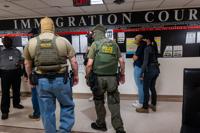
A shooter opened fire on the Centers for Disease Control and Prevention’s headquarters in Atlanta on August 10. (By Daniel Mayer / Wikimedia Commons)
The Centers for Disease Control and Prevention has for decades spearheaded federal efforts to understand and reduce gun violence. Sweeping cuts imposed by the Trump administration are now threatening that work.
As The Trace reported this past spring, the administration forced the CDC to lay off more than 2,400 employees, including teams responsible for gun violence research and prevention. The agency’s Division of Violence Prevention is estimated to have lost about three-quarters of its staff. Dozens of employees in the CDC unit that runs the WISQARS gun death and injury database were also let go.
Aside from layoffs, the administration has proposed slashing the CDC’s funding in half and eliminating a number of programs, including the firearm research division. A bipartisan Senate plan for the upcoming fiscal year would keep the agency’s budget largely intact, but it will need approval from the House, where conservative Republicans have been clambering for cuts. This month, a group of laid-off CDC staffers blamed the administration’s “villainization” for inspiring a Georgia man to fire dozens of bullets into the agency’s headquarters in Atlanta, killing a police officer.
Any more losses at the CDC could rob researchers, policymakers, and journalists of one of the most reliable sources of gun violence data. To show what’s at stake as Congress moves to enact the agency’s next budget, we compiled 10 examples of how the CDC’s gun violence work has helped reveal trends, shape interventions, and inform policy.
Galvanizing Prevention Efforts
In June 2024, then-U.S. Surgeon General Vivek Murthy issued his office’s first-ever advisory on gun violence. It relied on CDC data and related research to make the case that gun violence is an “urgent public health crisis.” Even though the Trump administration withdrew the advisory in March, it had already reinvigorated anti-violence efforts. Researchers and doctors cited the advisory in calling for more accountability in the gun industry, and in encouraging their colleagues to counsel patients about gun safety. The National League of Cities urged local leaders to use the advisory as a roadmap for reducing gun violence. In Massachusetts, the advisory spurred the creation of a gun violence prevention grant program.
Disarming Domestic Abusers
CDC data has consistently shown that when an abusive partner has access to a gun, the risk of a woman being killed increases dramatically. This and other agency-backed research has driven laws to prevent domestic abusers from possessing firearms. Colorado in 2021 passed legislation meant to ensure that suspected domestic abusers surrender their firearms when they become subject to a restraining order. The bill’s sponsor, State Representative Monica Duran, rallied support by citing CDC-supported research. The following year, CDC data played a role in Congress passing the Bipartisan Safer Communities Act, which partially closed a loophole that had allowed people convicted of misdemeanor domestic violence to keep their guns if their victim was a dating partner.
Protecting Children and Teens
In 2022, researchers at the University of Michigan, Ann Arbor, analyzed CDC data and found that, for the first time, firearms had overtaken motor vehicle crashes as the leading cause of death for Americans under 18. Their findings, published in the New England Journal of Medicine, sparked calls from advocates and lawmakers for increased violence prevention funding and requirements to make guns less accessible to children. The study also shaped new prevention strategies, interventions in schools, and public awareness campaigns on the importance of storing guns securely.
Combating Suicide Among Black and Brown Young People
The Trace has used CDC data to report on surging gun deaths during the COVID-19 pandemic, the prevalence of accidental gun deaths, the disproportionate toll gun violence is taking on Gen Z, and the rise in fatal shootings of children.
In a 2022 analysis of CDC data, we found that gun suicide rates among young people of color were rising at an alarming pace. While the firearm suicide rate for white teens rose 35 percent over the past decade, it more than doubled among Black, Latino, and Asian teenagers, and surged 88 percent among young Native Americans. The analysis catalyzed new research on suicide prevention efforts and the mental health needs of communities of color.
Spurring Bail Reform
Because gun charges account for a sizable share of arrests and convictions, cash bail is deeply connected to gun violence. In 2024, Drexel University researchers set out to test the narrative, pushed by politicians from both major parties, that reforming the bail system would threaten public safety. The researchers focused on New Jersey, which had largely replaced cash bail with a system through which courts evaluate a defendant’s risk of reoffending. The study — based partly on CDC data — found that, despite causing a sharp drop in the state’s jail population, the reforms had no effect on shootings. The study provided fresh momentum for bail reform nationwide.
Revealing Gun Violence’s Link to Climate Change
The CDC helped establish a body of research linking hot weather to increased gun violence. A sweeping 2025 meta-analysis published in the Journal of Urban Health synthesized 46 studies — several of which used CDC data — and found that more than 90 percent reported associations between heat exposure and crime. The findings have fueled follow-up research showing that housing improvements and heat mitigation strategies like tree cover can help reduce violence. City officials and public health advocates have used the research to push for expanded green spaces, improvements to housing stock, and other programs.
Calculating the Cost of Gun Violence
CDC data is vital to understanding the financial toll of gun violence. According to the agency’s latest available data, medical expenses for firearm injuries surpassed $286 million in 2023, while associated costs, including the value of the years of life lost, totaled nearly $505 billion. Advocates and policymakers often point to these figures when arguing for gun violence prevention as not only a public safety need but also an economic imperative. City and state leaders regularly cite the data when pushing to increase funding for violence prevention programs and trauma recovery services.
Improving Treatment of Gunshot Injuries
Knowing when shooting victims are most likely to show up at emergency rooms can help hospitals plan ahead and have enough staff on hand to provide faster and better care. For a study published in Annals of Internal Medicine in April, CDC researchers analyzed more than 125 million emergency room visits over a nearly six-year period. The data came from nine states and Washington, D.C., places that had received CDC funding as part of an agency effort to better track emergency room visits for gun injuries. The data showed that visits occurred most often during evenings, weekends, summer months, and holidays — particularly New Year’s Eve and Independence Day. The study also underscored the strain of violence on hospitals: On average, the researchers found, an emergency room treats a shooting victim every 30 minutes.
Fighting Suicide in Utah
In Utah, the CDC initiative to collect shooting data from emergency rooms has helped address the state’s persistently high rates of suicide, particularly among rural residents. State agencies and local officials have launched interventions, created a suicide task force and statewide prevention plan, and expanded mental health resources in communities where suicides are climbing — efforts credited with saving lives.
Stopping Gun Violence Before It Happens
The CDC has also funded and conducted research to identify the factors that make people more susceptible to being victims or perpetrators of violence, like poverty, unemployment, and unstable housing. These findings have helped community groups tackle the drivers of shootings before they occur. In 2017, Milwaukee used CDC resources to develop its “Blueprint for Peace,” which led to the city’s first hospital-based violence prevention program. The program provides mentoring and conflict resolution to gunshot victims to prevent cycles of retaliatory violence.











(0) comments
Welcome to the discussion.
Log In
Keep it Clean. Please avoid obscene, vulgar, lewd, racist or sexually-oriented language.
PLEASE TURN OFF YOUR CAPS LOCK.
Don't Threaten. Threats of harming another person will not be tolerated.
Be Truthful. Don't knowingly lie about anyone or anything.
Be Nice. No racism, sexism or any sort of -ism that is degrading to another person.
Be Proactive. Use the 'Report' link on each comment to let us know of abusive posts.
Share with Us. We'd love to hear eyewitness accounts, the history behind an article.